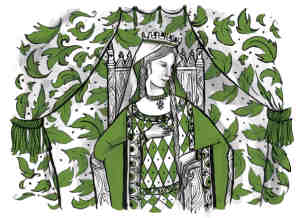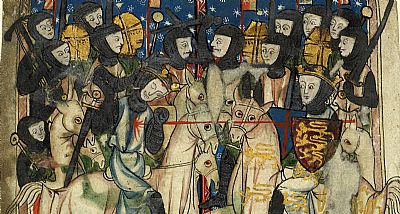OLD ENGLISH & WEST SAXISH
Ældu Englisc 7 Westseaxe
The Anglo-Saxon population during the 10th century are presumed to have spoken Old English but texts were usually written in Latin. Aelfric wrote in Latin and in vernacular Old English (West Saxish).

Anglo Saxon Heptarchy c A.D. 8th century
Old English/Anglo-Saxon (Ænglisc, Englisc, Onglisc)
Old English was a West Germanic language (belonging to the North Sea Germanic branch), spoken in England/Englalond between the 5th and 11th centuries until the arrival of Norman French in 1066 with William the Conqueror.
This North Sea Germanic branch, known as Ingvaeonic*, is ancestral to Anglo-Frisian and also to Old Saxon. Its daughter languages are Anglo-Saxon/Old English and Old Frisian.
The speakers of O.E. apparently called their language Englisc, never Seaxisc. 'West Saxish' is a modern interpolation, a retrospective descriptor, as is 'Anglo-Saxon'. The latter terms are neither original nor of Medieval provenance.
The speakers of O.E. called themselves Engle (Angles), Angelcynn or Angelfolc.
The speakers of O.E. later called their home Englalond i.e. 'the land of the Angles'. Prior to the name England, the older name of Saxland (Seaxeland) prevailed. It signified the realms of King Ælfred, located south of the Thames and west of Watling Street, areas excluded from the Danelaw as determined by the Treaty of Wedmore. Saxland (Seaxeland) may have included Essex.
The charters of the first decade of King Ælfred's reign generally referred to him as 'rex Saxonum' ('king of the Saxons'). After the capture of London (A.D. 886), Ælfred's royal style shifted to variations on 'rex Angulsaxonum' ('king of the Anglo-Saxons'). A significant shift in royal styling came when he used the title Rex Anglorum Saxonum - King of the English and Saxons, with the indisputable assumption that the king now ruled over two distinct peoples, but under a Latinised regnal title. The word 'king' in Latin is 'rex' but in Old English is 'cing', 'cyng', 'cyngc' etc. (tribal leader), an alternative to 'rex' was 'imperator' to emphasise imperium over other peoples in Britain.
'England' emerged as a distinct political entity in the 9th century. The earliest recorded use of the name, as "Engla londe", was in the late ninth century translation into Old English of Bede's Ecclesiastical History of the English People. The term was used then in a different sense to the modern one, meaning "the land inhabited by the English", and included English people in what is now south-east Scotland but which was at that time part of the 'English' kingdom of Northumbria. The Oxford English Dictionary confirms that the first reference to the southern part of the island of Great Britain as a political entity was in A.D. 897, although the first time it was spelled England, as it is today, was in 1538.
To place the name of England in its historical context, there was believed to be another, older, name for the regnal territories. In 930, the English King Æthelstan used the title: rex et primicerius totius Albionis regni ("king and chief of the whole realm of Albion**"). His nephew King Edgar styled himself: totius Albionis imperator augustus ("august emperor of all Albion") in 970.
*Pliny: the Ingvaeones tribe comprised the Cimbri, Teutons and Chauci.
An Ingui is also listed in the Anglo-Saxon royal house of Bernicia. Since the Ingvaeones form the bulk of the Anglo-Saxon settlement in Britain, they were speculated to have given England its name. The original Ingul tribe were extremely archaic and their provenance will be considered in due course.(January 2016)
** Note that there is a well documented, though not necesssarily accurate, connection between Alba/Albion and 'Scotland', home of the Dalriadan Gaels from Ireland; it will be discussed in due course. (February 2016)
Current Definition of Terms
Old English = Anglian = Northumbrian + Mercian
Anglo-Saxon/Anglo Saxish = Alfredian (variant) = Early 'West Saxish' (EWS)
West Saxish = Aethelwoldian (variant), as developed by Aelfric = Late 'West Saxish' (LWS) = the official language of the southern and western parts of 'England' until A.D. 1066. It continued in the southern and western counties of 'England'. After the 13th century it continued as unwritten dialect.
Dano-English = the 'English' language of the Danelaw region.
Dano-English + French = 'English' after the 12th century = Chancery English = the official language of 'England' in the later Middle Ages.
Traditional Definition of Terms
Anglo-Saxon (obsolescent term) = Old English = Anglian +EWS=LWS
The overall picture is complicated by the fact that the Saxons called their written language (including the Aethelwoldian variant) Englisc, not Seaxisc. A further complexity arises from the practice of attempting to make the Aethelwoldian variant conform to a modern 'normalised' standard based on the Alfredian variant, for example, substituting 'ond' for 'and'; 'hond' for 'hand'; 'lond' for 'land'; 'mon' for 'man', etc.

WRITING
Anglo-Saxon runes (futhorc/fuþorc)
Old English / Anglo-Saxon was first written with a version of the Runic alphabet known as Anglo-Saxon or Anglo-Frisian runes, or futhorc/fuþorc (so-called after the first six letters of the alphabet, f.u.th.o.r.c). This alphabet was related to the smaller alphabet in Scandinavian Runic version of Elder Futhark. The runic alphabets evolved and originated on the continent, in Northern Italy where they were used to write the Old Italic languages such as Etruscan, Rhaetian, Volscian, Oscan, Umbrian and Ligurian - the latter used for the Gaulish rune alphabet.
There were a larger number of Anglo-Saxon runes than the later Elder Futhark alphabet - which had 24 letters (three staves of eight) - whereas the Anglo-Saxon runes had 26 letters in the early English version and after a further extension, 33 letters in the latest version. Tthe Scandinavian Runes were said to be fewer in number in concordance with their sound system. Anglo-Saxon runes were probably in use from the 5th century A.D. until about the 11th century. The New Latin alphabet (as opposed to the Old Latin based on Etruscan Runic alphabet} started to be used from the 7th century in the North of England under Irish tutelage
After at least five centuries of use, fewer than 200 artifacts bearing futhorc (runic) inscriptions have survived. Runic finds in England cluster along the east coast with a few engraved on portable objects scattered further inland in southern England. There are Kentish examples of runes being inscribed on coins. Latterly, most runic inscriptions were found on monuments in the North, sometimes mixed with Latin letters and in a Christian context. The 33 late English runes show evidence of having been influenced by the Latin alphabet, e.g., by the addition of a rune representing [q]. A notable example of the use of runes in a Christian context is the Franks Casket.
The use of runes had always been for inscriptions, most noticeably on monuments, particularly in the North East, only appearing in manuscripts for antiquarian interest. Their use ceased not long after the Norman Conquest.
Old English Alphabet
Old English began to appear in the Latin alphabet during the early 8th century in the North, with Caedmon's Hymn probably the earliest extant example. Most texts were written in West Saxish, one of the four main dialects. The other dialects were Mercian and Northumbrian (together known as Anglian) and Kentish, which, although distinct from both Anglian and West Saxish, was probably closer to West Saxish than to Anglian (certainly later). An example of dialect difference is the replacement of [f] by [v]. Kentish was characterised by the use of [e] whereas West Saxish used [y] and Anglian used [i], which accounted for the pronunciation of bury as berry.
The Anglo-Saxons adopted the styles of script used by Irish missionaries, such as Insular half-uncial, which was used for books in Latin. A less formal version of minuscule was used to write both Latin and Old English. From the 10th century Anglo-Saxon scribes began to use Caroline Minuscule for Latin while continuing to write Old English in Insular minuscule, thereafter, Old English script was increasingly influenced by Caroline Minuscule even though it retained a number of distinctive Insular letter-forms.
A small number of runic letters were adopted to supply symbols for [th] (thorn , Þ, þ), and [w] (wynn), whether directly from the English runes or from the Greek-inspired Gothic alphabet is not clear. Also from a Greek origin came [y] to supply the sound of French [u] and probably 'thet' (Ð, ð, representing 'theta') as an alternative to 'thorn'. 'Thet' is commonly referred to as 'eth', probably after Icelandic 'edh'. The name of the runic letter 'Aesc' was adopted for the ligatured letter [Æ, æ],
Alfredian West Saxish
'Alfredian' refers to the language employed by King Alfred (849–899) for the many literary translations produced under Alfred's patronage (some perhaps by Alfred himself). The language of these texts nonetheless reflects the influence of other dialects besides that of West Saxish. It is the language which can best be described as Anglo-Saxon, reflecting the Anglian, Saxish and Kentish of its authors many of whom had fled from the Danish invaders bringing with them the skill of writing in the vernacular dialects of their home regions.
Aethelwoldian West Saxish
By the eleventh century, the 'Alfredian' language had been replaced by 'Aethelwoldian', following the Aethewoldian language reform set in train by Bishop Æthelwold of Winchester. The name most closely associated with that reform is Abbot Ælfric of Eynsham, Ælfric the Grammarian. Despite their similarities, Aethelwoldian West Saxish is not considered to be a direct descendant of Alfredian.
Aethelwoldian West Saxish was the dialect which became the first standardised written "English" ("Winchester standard"), sometimes referred to as "classical" Old English. This dialect was principally spoken in the south and west around the important monastery at Winchester, which was the capital city of the Saxon kings. Whilst other Old English dialects continued to be spoken in other parts of the country, it seems that all scribes wrote and copied manuscripts in this prestigious written form. Well-known poems recorded in this language include Beowulf and Judith, however, each of these poems appears to have been written originally in other Old English dialects which were later translated into the standard Aethelwoldian literary language when they were copied by scribes.

Duke William of Normandy (conqueror of West Saxish language)
Following the Norman Conquest, Aethelwoldian was itself eclipsed as the standard written language by the Anglian Dano-English (Chancery English) of the East Midlands which by the 12th century had incorporated numerous words from Norman French and Central French. It should be noted that just as Aethelwoldian was not the direct descendent of Alfredian, West Saxish was not the ancestor of the English spoken today. Although West Saxish is the most studied form of Old English, it is only a poor guide to the Anglian English of the East Midlands which developed into modern standard English.
Middle English Alphabet
A differentiated [g] was derived from the form of [g] used in writing Old English to represent the sounds [ç] or [x]. It was later replaced by [gh] or [y], hence the name. 'yogh'. In the late Middle Ages it was of represented by the letter [z], as [þ] was represented by the letter [y] e.g., 'Ye Shakespeare Inn'. 'Wynn' fell out of use and was replaced by [uu/vv], hence the name, [double u]. In the early modern period, the doubled letters were merged to form [w].
The alternate forms of g and w (yogh and wynn/wen respectively) were based on the letters used at the time of writing Old English. Today they can be substituted for g and w in modern writing of Old English.
Yogh originated from an insular form of g and wynn/wen came from a runic letter and was used to represent the non-Latin sound of [ w ]. The letters [ g ] and [ w ] were introduced later by French scribes. Yogh came to represent [ ç ] or [ x ].

"English developed as the Germanic of few invaders in the mouths of many Celts"
(Vennemann)

